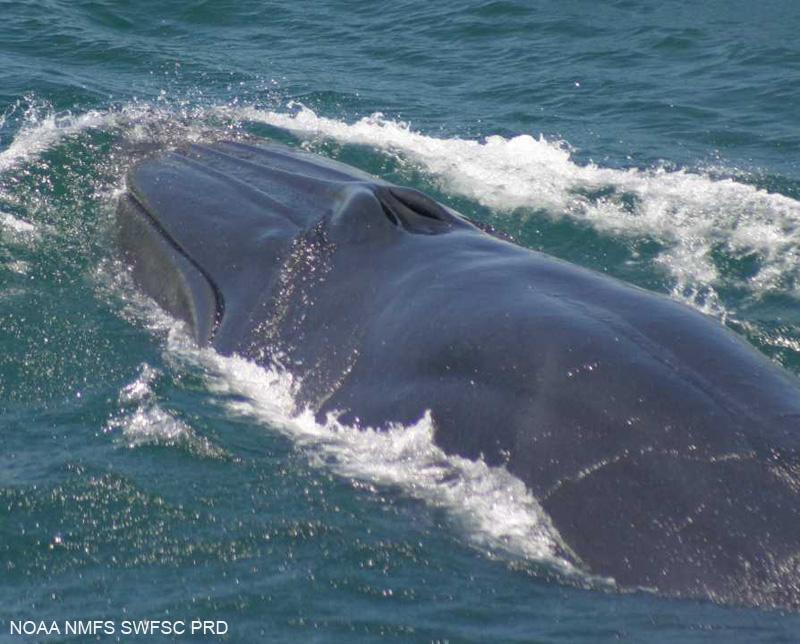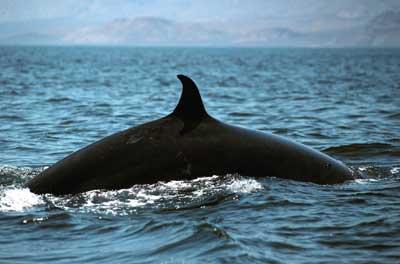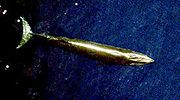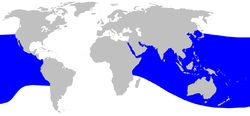Common Name: Bryde’s Whale
General Description: Bryde’s Whales (pronounced brood-ess) resemble Sei Whales B. borealis closely. The heads of the two species are similar in profile and general appearance at a distance. Most Bryde’s Whales have three prominent ridges on the head ahead of the blowholes, one medial, and one on each side from the area adjacent to the blowholes towards the tip of the snout. When present, the three ridges are diagnostic of the species.
The dorsal fin is up to 46 cm tall, sickle-shaped and pointed. It is located about one-third of the body length forward from the tail fluke notch.
Bryde’s Whales are generally dark grey above. The throat and chin have some white. Some individuals have regions of light grey on each side, forward from the dorsal fin.
Bryde’s Whales are also known as Tropical Whales.

Size: Adults, Males grow to a length of 14 m, and females to 15.6 m. The weight is about 17 tons. Two forms exist in some areas, one coastal and one offshore. The offshore form is apparently slightly larger. Calves at birth, 4m long.
Appearance At Sea: Bryde’s Whales often approach vessels at sea, permitting close observation, like Minke Whales. They often turn on to their sides when feeding. Bryde’s Whales are usually found in groups of 5–6 animals.
The movements of this whale are said to be fishlike and jerky. The Sei Whale, with which it is confusable, normally moves sedately.
Bryde’s Whales surface to breathe by rising steeply such that the head is exposed, and then roll over so that a long expanse of the back is visible. The spout of the Tropical Whale is a typical tall thin rorqual blow, around 4m high.
Found In: Both the coastal and the offshore forms prefer warm water above 20°C. The inshore form is resident whilst the offshore form is migratory. Bryde’s Whales feed mainly on schooling fish, together with planktonic crustacea.
Date : [?]
Details : Recorded from the Bay of Bengal by Blanford.
References : De Silva, 1987
Date : 2 July 1979
Details : A 13m specimen washed ashore at Beypore, Calicut.
References : Lal Mohan, 1992
Date : 14 April 1982
Details : Seven of these whales seen on a cruise from Madras to Trincomalee.
References : Leatherwood, 1984
Date : 20 February 1983
Details : A 13.52 m long carcass found on an islet near Dhanushkodi Island in the Gulf of Mannar.
References : Lal Mohan, 1992
Date : 14 November 2000
Details : A 12 m long animal stranded near Point Calimere.
References : Sathasivam, 2001
Individual Bryde’s Whales seen at sea off Sri Lanka have been re-sighted after a period of two years, leading to the suggestion that they may be resident in the area or annual visitors there. Sightings of the species have been made in the southern Arabian Sea, southern Bay of Bengal, and near Djibouti and Somalia. Strandings are known from Pakistan and Iraq.

World Distribution: Bryde’s Whale is found in tropical and subtropical waters of all seas.
Could Be Confused With: There is a possibility of confusion with the Sei Whale Balaenoptera borealis. The two species can be distinguished as follows:
Species : Bryde’s Whale
Ridges : Three ridges on head
Fin: Small, sharply pointed, sharply pointed, often notched
Surfacing : Surfaces erratically
Blow : 4m blow
Submerging : Rolls over with arched tailstock
Colouration : White throat often visible
Response to Ships : Often approaches ships
Movement : More jerky, fishlike movement
Species : Sei Whale
Ridges : Single head ridge
Fin: Large, less pointed, more sloping
Surfacing : Breathes regularly
Blow : 3m blow
Submerging : Sinks quietly below surface
Colouration : Dark, shiny appearance
Response to Ships : Never approaches ships
Movement : Normally sedate movement
Diagnostic Features: At sea, Three ridges on head, small sharply pointed fin, white throat.
Stranded Specimens: The baleen plates number 250 to 370 and are slate-grey. They are 42 cm long and 24 cm wide. The bristles on the plates are usually light grey, sometimes fine and white, sometimes black.




